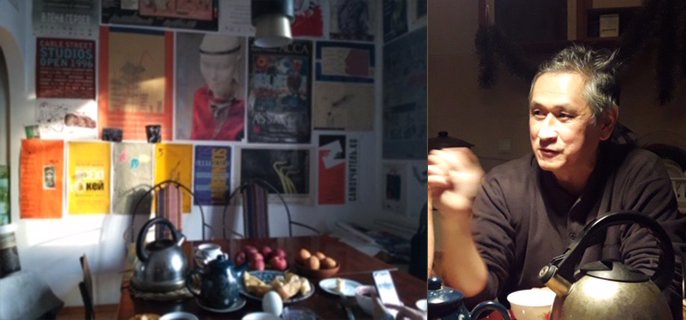
A leading figure of Bishkek’s post-Soviet arts scene: CAF interviews Ulan Djaparov as the latest instalment in the Creative Bishkek series.
Ulan Djaparov is seen by some as the godfather of modern and contemporary art in post-Soviet Bishkek.
Alongside founding a contemporary art and architecture space, Studio Museum, he is a driving force of the city’s recent artistic boom through his work on social media – primarily as the administrator of the influential Facebook group Central Asian Pavilion of the Contemporary Art.
What is Studio Museum and why did you create it?
The architectural studio Museum has a long history. In 2018, we celebrated the 20th anniversary of the studio’s official status and the thirty-first anniversary of the creation of the group Museum. During this time, there have been several generations of ‘
Natives of the studio are now working in various cities in the world – from Vladivostok to Cologne, and from Moscow to Auckland. The
How much has the contemporary art scene in the city changed in the last few years and how have you contributed?
Modern and contemporary art as a phenomenon appeared in Kyrgyzstan relatively recently – a little more than 20 years ago. Originally, there was not a single art institution or official centre for contemporary art. Everything was done on personal enthusiasm. The museum and I, as the curator of many of the first exhibitions, were among the several initiators of this process.
Nowadays there are a couple of generations of young artists and art activists, with new ideas and forms of existence. Of course, there are some minor differences between groups – the generation of 35 to 40-year-olds still remember the Soviet era, the difficulties of the 90s and so on. The generation of 20 to 25-year-olds is already very different – they are more mobile, practical, not so tied to ‘old’ values.
Nonetheless, everything still depends on the personal drive of artists in Bishkek, insofar as the commercial art is itself out of reach, Bishkek’s modern art scene is still led by the artists’ personal interest and desire to put forward challenging ideas.
Do you participate in other projects in the city, and if so, which ones?
Our studio Museum is quite specific, and has been since its creation. We mainly cooperate with good friends who have interesting ideas and we help them to design and visualise them their ideas architecturally. Ideally, we help them to realise what is not always possible. Often, this is the development of architectural concepts. In addition, sometimes we organise exhibitions of contemporary art.
We cooperate with young, but also more experienced, artists from all over Central Asia. A few years ago, I was the editor-in-chief of the Central Asian almanac Kurak (art and society). Recently, we began to cooperate with some NGOs. For example, we are developing and recommending on ‘setting models of a safe educational environment with the help of design in pilot schools of Kyrgyzstan’.
What is the role of modern culture in the development of Kyrgyzstan?
The situation is interesting. Everyone has a different understanding of what modern culture is. Some appeals to some kind of archaic or purely national forms and wrap them in modern packaging, others try to relay to us ‘universal cultural values’ (but often this is the result of working off grants, or for marketing purposes), while again someone else is looking for/creating a culture at the junction between our real situation and specific and modern form.
Meanwhile, there is a large layer of religious culture in the background, which is becoming increasingly pronounced every year. Modern culture has only really taken form in the urban space, as the population of the city has greatly changed since the 1990s.
How important is cooperation between creative people in the city?
I think that the concept of creative people is somewhat broad and vague, but the process of cooperation itself is interesting and this is almost our only opportunity to do something interesting here in our current situation. And if earlier there was some tightness in different social groups and strata, now there is a certain interest in interdisciplinary projects and cooperation.
How is Bishkek changing? Are these changes primarily positive?
Bishkek is changing a lot; some people see this as positive, while others lack the same enthusiasm. Outwardly, Bishkek has turned into a larger city (high-rise buildings, shopping
For example, there have some rather aggressive new developments in the city that do not consider the current context and primarily have money as a motivating factor. The problem does not only concern short fallings in town-planning policies, but also concerns a vanishing social consensus about common cultural values; especially with respect to prevailing urban environments and their connections with private initiatives.